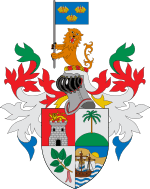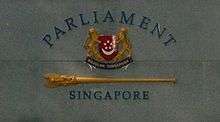List of coats of arms used in Singapore
This is a list of the coats of arms that are currently used in Singapore, or have been used during its history.
Official coat of arms
Government
Military
| Coat of Arms | Duration | Description | Comments |
| Link to image | 1960–present | Badge of the Singapore Armed Forces as well as the Singapore Army | The emblem's escutcheon reads "Tentera Singapura" (meaning "Singapore Army" in Malay). The national coat of arms sits in its interior. The motto is "Yang Pertama Dan Utama" ("first and foremost" in Malay). Two stalks of laurel flank the escutcheon. |
| | 1959–present | Crest of the Republic of Singapore Navy | The emblem contains the national coat of arms, and below it an anchor which epitomises naval roots and signifies continued adherence to naval values. The lion represents courage, nobility and sovereignty which symbolises the nation and how the RSN will act in defence of Singapore. The tiger represents fierce determination and aggressive deterrence in how the RSN will carry out the duty of protecting the nation. The laurels are the hallmark of excellence that reflects the professionalism and dedication that goes into the making of the RSN. |
| | 1968–present | Crest of the Republic of Singapore Air Force | The crest consists of the national coat of arms supported by the silver wings of the Air Force within a bowl of golden laurels. |
Historic
| Coat of Arms | Duration | Description | Comments |
.svg.png) | 1819–1826 | 1819–1837 version of the Royal coat of arms of the United Kingdom | Used during the reigns of George III, King George IV and King William IV. |
 | 1826–1942, 1945–1946 | Coat of arms of the Straits Settlements | Quarterly, the first quarter gules, issuant from the base a tower proper, on the battlements thereof a lion passant guardant Or; the second quarter argent, on a mount an areca nut palm tree proper; the third quarter also argent a sprig of the oil tree keruing proper; the fourth quarter azure in base on waves of the sea in front of a representation of the sun rising behind a mountain, a sailing yacht in full sail to the sinister, all proper. Crest: A demi-lion rampant guardant supporting in the paws a staff proper, thereon flying to the sinister a banner azure, charged with three imperial crowns Or. |
 | 1942–1945 | Imperial Seal of Japan | Used during the Japanese occupation of Singapore. The seal shows a 16-petal chrysanthemum. |
.svg.png) | 1946–1952 | 1837–1952 version of the coat of arms of the United Kingdom | Used when Singapore was a Crown colony in her own right following the dissolution of the Straits Settlements in 1946, during the reigns of Their Majesties Queen Victoria, Edward VII, George V, Edward VIII and George VI. |
 | 1948–1959 | Coat of arms of the Colony of Singapore | Used when Singapore was a Crown colony. |
 | 1952–1963 | Royal coat of arms of the United Kingdom currently used by Her Majesty Queen Elizabeth II | Used when Singapore was a Crown colony and, from 1959 to 1963, a self-governing state within the British Empire. Quarterly, first and fourth Gules three lions passant gardant in pale Or armed and langued Azure (for England), second quarter Or a lion rampant within a double tressure flory-counter-flory Gules (for Scotland), third quarter Azure a harp Or stringed Argent (for Ireland), the whole surrounded by the Garter; for a Crest, upon the Royal helm the imperial crown Proper, thereon a lion statant gardant Or imperially crowned Proper; Mantling Or and ermine; for Supporters, dexter a lion rampant gardant Or crowned as the Crest, sinister a unicorn Argent armed, crined and unguled Proper, gorged with a coronet Or composed of crosses patée and fleurs de lis a chain affixed thereto passing between the forelegs and reflexed over the back also Or. Motto "Dieu et mon Droit" in the compartment below the shield, with the Union rose, shamrock and thistle engrafted on the same stem. |
.svg.png) | 1963–1965 | Coat of arms of Malaysia | Used when Singapore was a state within the Federation of Malaysia. The crest shows a yellow crescent and yellow 14-pointed "Federal Star" (Bintang Persekutuan). The escutcheon of the emblem consists of a chief (upper portion) and a lower section that is divided in three per pale (longitudinally). The chief is gules charged with a row of five krises representing the five former Unfederated Malay States of Johor, Kedah, Kelantan, Terengganu and Perlis. On the left side of the lower section is the escutcheon of the former coat of arms of Penang consisting of the Prince of Wales's feathers which refer to Penang's founding in 1786 as Prince of Wales Island, and blue and white bars referring to the Straits of Malacca which surround the island. In the upper middle section below the chief are the colours found on the flags of the Federated Malay States: Negeri Sembilan, Pahang, Perak and Selangor. Below them are the state arms of Sabah, Singapore and Sarawak. On the right side of the lower section is a Malacca tree (Phyllanthus emblica) from the coat of arms of Malacca. Supporting the shield are two rampant tigers. The motto is "Bersekutu bertambah mutu" ("Unity is strength") in both Latin script and Jawi script. |
See also
.svg.png)


.svg.png)


.svg.png)


.svg.png)
